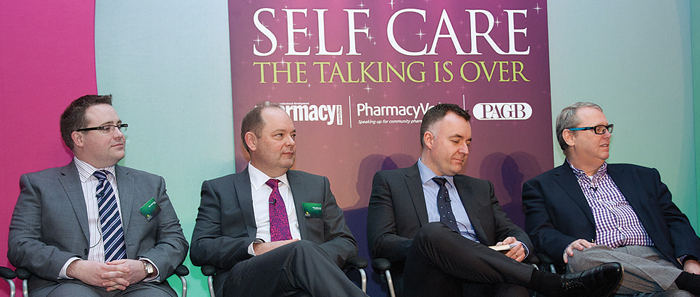Is the customer king?
In Event news
Follow this topic
Bookmark
Record learning outcomes

Last month's third annual SMART conference was the forum for an expert panel debate on whether the customer is king in pharmacy.
Mike Hewitson, NPA vice chairman, argued that the customer €was, is, and always will be€ king in pharmacy. But consumers were changing, he warned. They were better informed, had higher expectations and could express their opinion more powerfully through, for example, online reviews.
On the platform (l to r): Mike Hewitson, Steve Howard, Peter Bainbridge and Trevor Gore discuss pharmacy's service credentials
Consumer choice from pharmacy was €unparalleled€, Mr Hewitson told the conference organised by Pharmacy Magazine in association with the Proprietary Association of Great Britain and Pharmacy Voice. With a free choice of 13,500 pharmacies in €every conceivable setting€, the public could choose not only where and when they accessed pharmacy services, but also who provided them. This choice was unmatched by any other healthcare provider.
Pharmacy services delivered high satisfaction levels, particularly in the independent sector, where repeat business was important. And the public was turning to pharmacy for a wider range of treatments and services, such as those available via PGD, for example.
Empowering patients
The fact that 70,000 Londoners recently chose pharmacy for their flu vaccination was a sign of pharmacy's popularity. €Pharmacy can empower patients to make informed choices about their own health and wellbeing. We are the ultimate patient champions.€
Peter Bainbridge, director of pharmacy at Boots UK, warned that the customer must remain king or another profession would take over pharmacy's current services. The profession had listened to the Which? report, which €gave us a huge opportunity to learn€, said Mr Bainbridge. €Customer expectations are increasing so we have to get better.€
Boots received 30,000 responses every week to its customer survey, and a similar sized panel of customers was used to test new products and services. Its customer satisfaction levels increased from 45 per cent in 2007 to 71 per cent in 2013.
Trevor Gore, global healthcare training manager at Reckitt Benckiser, argued that the customer was no longer king in pharmacy. He highlighted the fact that the way that pharmacists spent their time had barely changed over the past decade and €repeated attempts€ to move the profession out of its €traditional dispensing role€ had been unsuccessful, according to researchers from UCL School of Pharmacy. This research also found that the proportion of time spent counseling had remained static, despite policies to encourage pharmacists to spend more time on direct patient care.
Pharmacists were not good at telling patients exactly what they offered, said Mr Gore. And he questioned whether the 18-year-old medicines counter assistant training syllabus was fit for purpose.
Steve Howard, quality and regulatory director and superintendent pharmacist at Celesio UK, argued that if the customer were king, pharmacies would provide exemplary service, high quality advice and services designed around individual needs. Instead, the most recent Which? report showed little improvement since the 2008 investigation, there were variable standards of practice and environment, and the WWHAM protocol was being used inappropriately. €We need to raise our game as a profession,€ said Mr Howard.
The OTC landscape
Although independent pharmacy's share of the OTC medicines market had fallen by around 25 per cent since 1993 to less than 10 per cent, independents had retained their market share since 2006, Martin Wood, business unit director at IRI UK, told the conference. Boots, however, had maintained its market share over the past 20 years.
While the total OTC market increased in size by 2.2 per cent since last year, with growth driven by topical pain relief, smoking cessation and hay fever, the long-term trend was for €fairly flat€ sales of OTC medicines, while prescription numbers continued to rise. Retailers' own brands accounted for around 20 per cent of value spend on OTC medicines, but for nearly two out of five of all packs sold.
Pharmacy medicines sales had declined by 33 per cent between 2003 and 2013, but GSL sales had increased by 36 per cent over the same period. This was a function of the lack of successful switches from POM to P and plenty of switches to GSL, said Mr Wood.
Electronic cigarettes had created a £90m market €out of nowhere€. Prescription sales were declining as a result, but OTC smoking cessation appeared relatively unaffected, increasing slowly to around £130m in 2013. IRI predicted that the e-cigarettes category would be worth £200m by 2014 and £300m by the following year. Steady growth for OTC smoking and a steady decline for prescription smoking cessation were also predicted.
